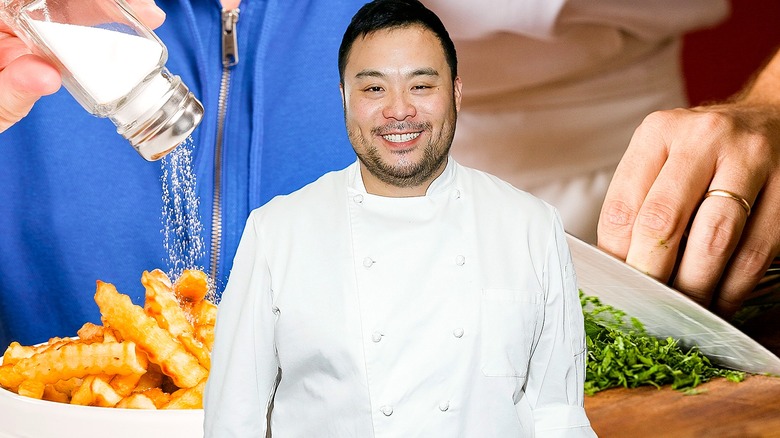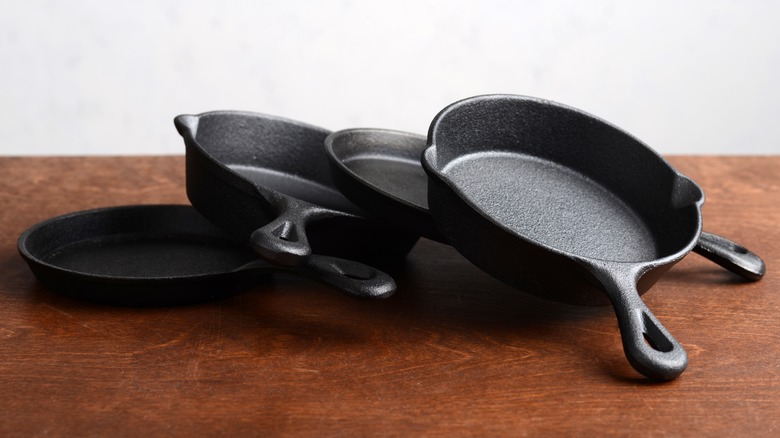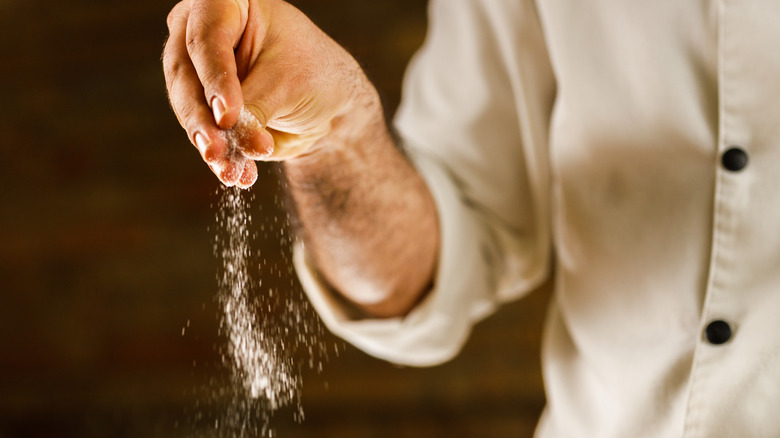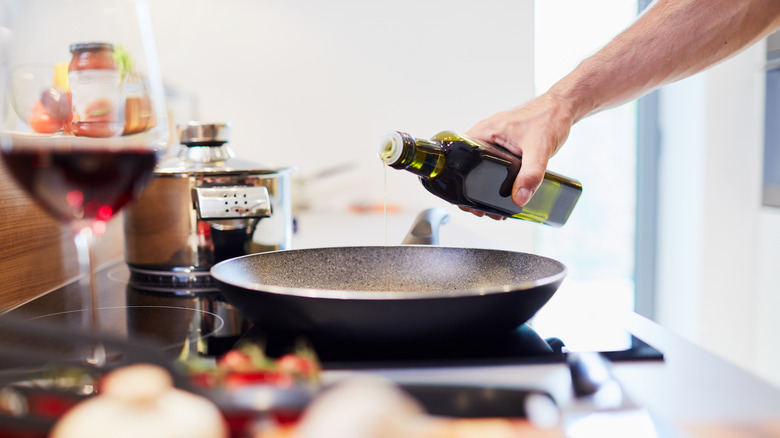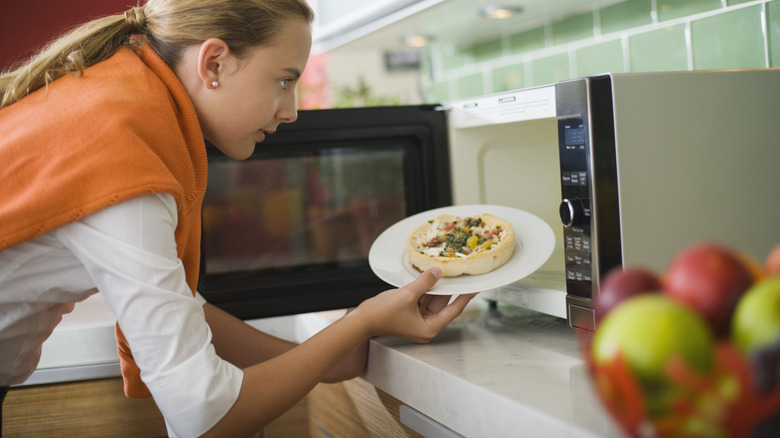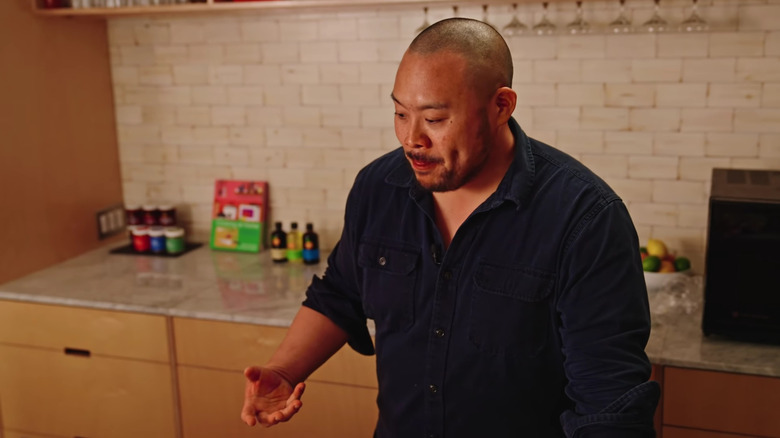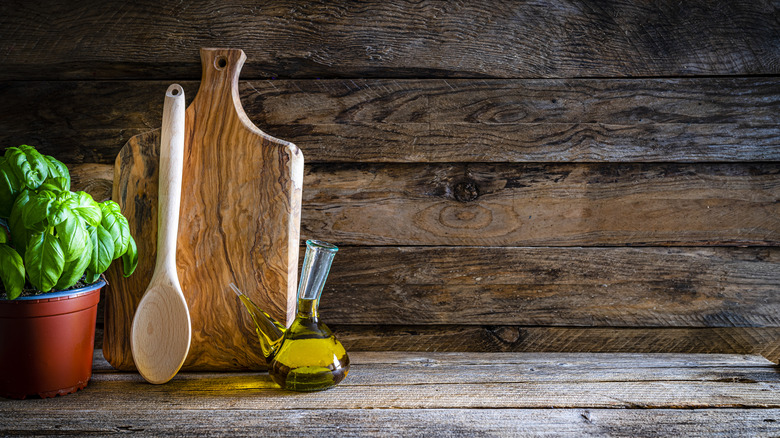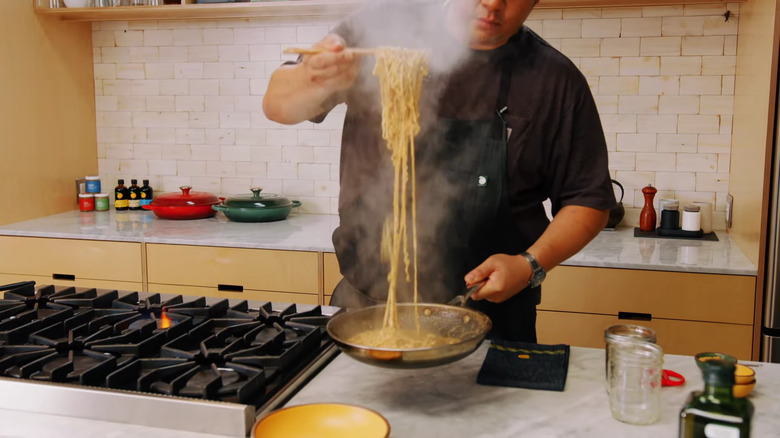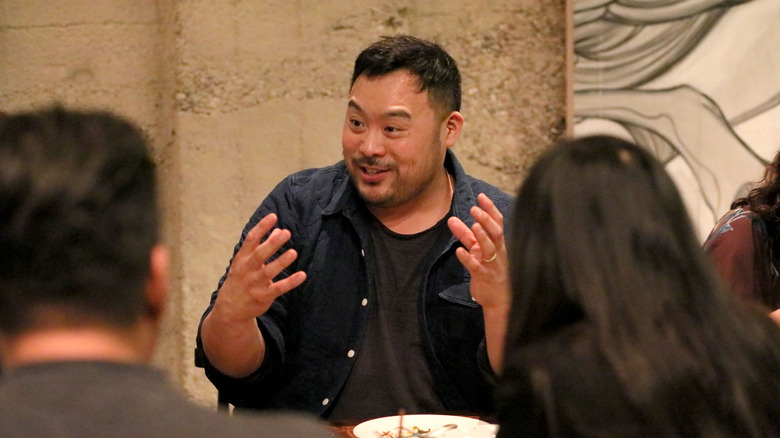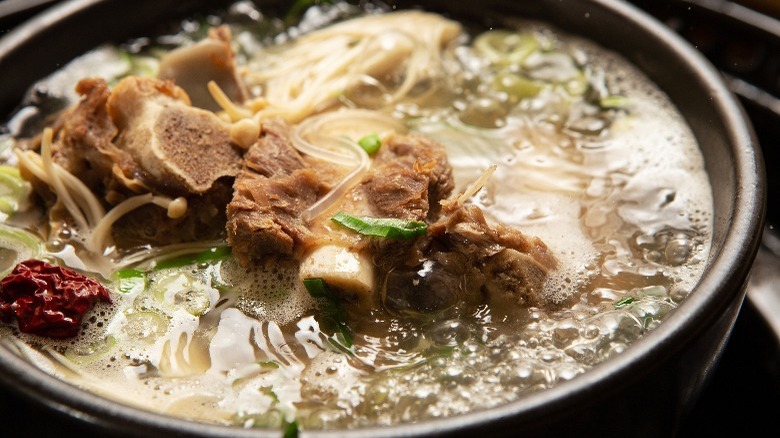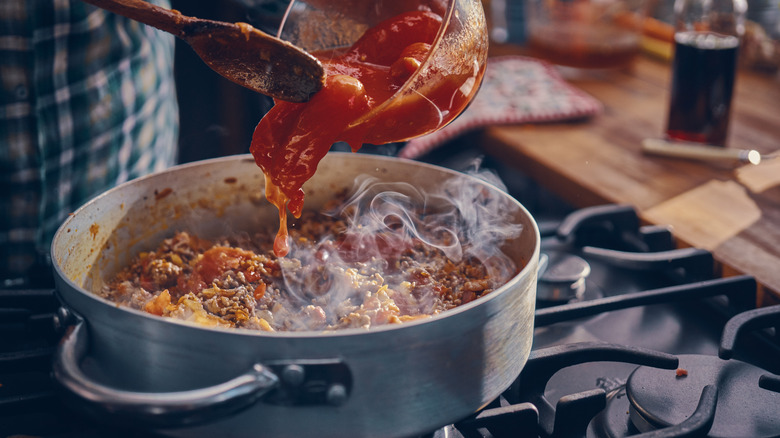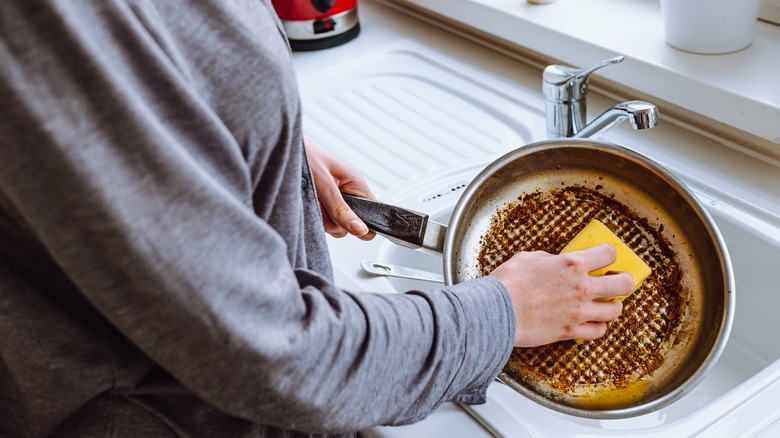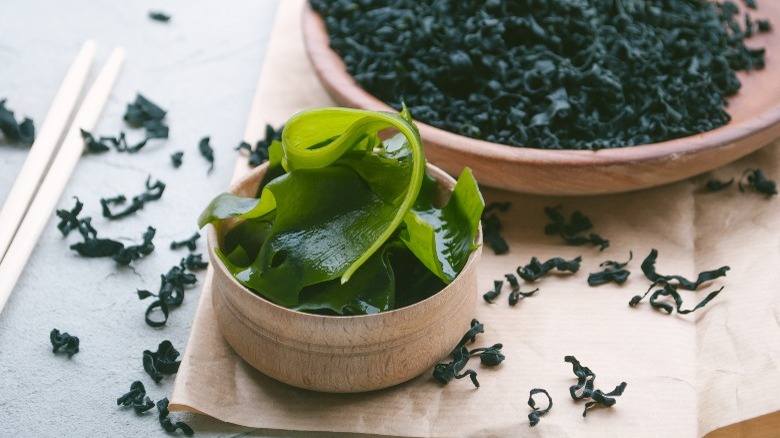12 Cooking Tips From Chef David Chang You Should Know
David Chang is one of the most celebrated American chefs. He burst onto the scene in 2004 when his New York City restaurant Momofuku Noodle Bar opened, quickly becoming known for its innovative, exciting cooking. Since this time, the Momofuku empire has grown substantially. At the time of writing, it encompasses six restaurants across three American cities, as well as a Toronto location.
Chang's cooking style has been defined as modern Asian cuisine. His nuanced understanding of ingredients, flavors, and techniques has allowed him to create many iconic dishes, including his much-praised Momofuku pork buns. Given the mouthwatering quality of Chang's dishes, it's no surprise that many people seek cooking advice from him.
As with any chef, Chang has several practical tips for home cooks. He does, however, differ from the norm by being highly philosophical regarding food. Consequently, these helpful tips come alongside conceptual musings on cooking, food, and the responsibility that comes with feeding others. These tips will vastly improve the cooking of every chef who pays attention.
1. Stock your kitchen with a few good tools
Good cooking begins with good tools. David Chang supports this sentiment but quickly dispels the myth that most home cooks need an incredible array of highly specialist equipment. Take knives, for example. In a story for GQ, Chang stated that home cooks only need three: a chef's knife, a serrated bread knife, and a paring knife. With these three, he claims, just about any cooking task can be completed. This advice is in contrast to the many home cooks that recommend owning extensive knife collections.
It's not only the number of knives recommended by Chang that is surprising, but their cost. He fiercely advocates for cheap paring knives, claiming that an affordable Victorinox knife is his personal favorite, according to The Daily Beast.
Pots and pans are another part of the kitchen that Chang advises focusing on. Chang champions high-quality materials including copper, enamel-coated cast iron, and cast iron. The cast iron pan is a particular favorite of Chang's, due to its versatility, an underlying theme of all kitchenware that he recommends.
Finally, Chang doesn't advise that home cooks fill their kitchens with clunky machines like ice cream makers and sausage grinders. He believes your time and money are better spent elsewhere, like at a restaurant.
2. Use plenty of salt
The best cooking requires a lot of salt. This tip is an oft-repeated one, but repetition does not diminish its validity. Chef Jacob Kennedy put it best when he spoke to The Guardian: "Correct seasoning to a chef is as much salt as you can put in without it tasting too salty." David Chang agrees that home cooks criminally underuse salt. When asked by Architectural Digest what was the most common blunder home cooks make, Chang said insufficient salt use.
The chef, however, believes that salting food is a little bit more complicated. He tries to find the perfect level of seasoning where food is simultaneously both under and over-salted, the chef told Wired. While this might sound impossible, Chang believes finding this specific point is integral to excellent cooking. He encourages all cooks to experiment by adding varying degrees of salt to glasses of water. When this fine line is found, "the saltiness paradox," as he calls it, keeps diners rooted in the moment, as they are forced to concentrate on their food constantly. Achieving the saltiness paradox might be difficult, but mastery over it will make your cooking immediately engaging.
3. Make sure your pans are hot before adding oil
A simpler tip to employ is pre-heating pans. David Chang tells Architectural Digest that cooks not allowing pans to heat up sufficiently before adding oil is a very common mistake. One of the reasons for adding the oil to a sufficiently-heated pan is that this prevents the oil from breaking down, which can give the oil an unpleasant texture. Other cooks, like celebrity chef Adam Richman, agree. The celebrity told People: "It's better to heat your pan first and then add oil. The longer oil sits on a hot surface, the more time it has to break down. Following this method, you'll use less oil, food will be less soggy, and you'll get a better sear."
The drawback of this approach is that it can be difficult to know how hot the pan is without pooling, shimmering, or smoking oil to inform you. Knowing your stove and getting more experience cooking with it will help you to master this tip.
4. Use a microwave
Although it might surprise a lot of people, David Chang is a staunch advocate of the microwave. His love for the appliance came about after he had children and cooking at home became a necessity. As he explained to House & Home, Chang turned to the microwave to achieve his new guiding principles: "I've had to learn to become a home cook for the first time in my life, and it's entirely different from how I cook at restaurants. Now I make stuff up out of necessity with my new guiding principles: to create something as delicious as possible, in the least amount of time possible, while making as little mess as possible."
His respect for the microwave as a culinary tool has been recorded in a cookbook he authored alongside food writer Priya Krishna. "Cooking at Home: Or, How I Learned to Stop Worrying About Recipes (And Love My Microwave)" highlights some of the best ways microwaves can be used to save time in the kitchen from cooking potatoes to making rice. Chang has also released a number of videos where he uses the microwave to make dishes including shrimp and grits as well as steamed mussels.
5. Allow yourself to improvise
David Chang found professional success when he gave himself, and his fellow chefs at New York's Momofuku Noodle Bar, the freedom to cook whatever he wanted, he told The Michelin Guide. Prior to making this decision, the restaurant was struggling. But after he allowed inspiration to lead the way, it became one of the best restaurants in New York City.
While improvising can be scary, it's also extremely rewarding, as Chang explained on YouTube: "What I actually enjoy quite a bit at home, or even say, when you're making family meal for your peers, is being able to experiment and learn how food can work in different combinations and also learning how to improvise, because, cooking without a safety net, it can be scary, but also I think it teaches you how to think; how to become a better cook."
Improvising can be as easy as looking in your cupboard and deciding what to make for dinner, or riffing on a favorite recipe that you cook often. Whichever approach you choose, the basis of good improvisation is solid technique and an understanding of flavor. Both of these are developed through practice. Don't be afraid to give improvised cooking a whirl. Even if the final dish isn't great, you will have learned some valuable lessons along the way.
6. Use a wooden cutting board
One piece of equipment that David Chang is adamant every cook needs is a wooden cutting board. He highlighted this in an interview with Architectural Digest. Speaking about cutting boards, Chang told the magazine: "Boos blocks make great cutting boards. They're expensive, but they will last, and you don't have to maintain them too much. Just don't get the cheap plastic one."
There are good reasons to look down on plastic cutting boards. Although cheap, the grooves that get cut into them often harbor dangerous bacteria. Wood's natural antibacterial properties, on the other hand, help reduce the amount of bacteria present on the surface. What's more, the hard plastic can prematurely dull and damage knives. Wooden cutting boards do so but to a much lesser degree. The only downside to wooden cutting boards is that they require greater care to maintain. This, however, is a small price to pay for the myriad benefits they offer. You, your kitchen utensils, and your cooking.
7. Recreate flavors in novel ways
Just as David Chang's saltiness paradox has the ability to grab the diner's attention, so does his ability to recreate familiar flavors in novel ways. The dish that best exemplifies this approach is Momofuku's "Ceci e Pepe," a spin on the Italian classic cacio e pepe. Here, Chang recreates the umami-rich flavor of pecorino romano with a fermented chickpea hozon (a type of miso-like paste). The result is a dish that looks and tastes familiar, while being something completely new, a thrilling experience that transcends the act of eating.
This type of tip may seem daunting to new home cooks, yet it's easier to achieve than it seems. In fact, any substitutions you make when cooking can count. Of course, the more adventurous these swaps become, the greater the potential payoff, but also the greater chance of disaster. For beginners, start simply by swapping out salt for soy sauce or using spiralized zucchini instead of noodles. You could even try using anchovies to create fishy flavors in a sauce.
8. Don't worry about authenticity
In order to recreate flavors in novel ways, chefs must turn their back on the pursuit of authenticity. This is easier said than done; the food world often romanticizes authenticity. Fortunately, there is a growing understanding that "authentic food" does not exist in a literal sense and that all cooks create their own version of dishes.
Chang expressed a similar sentiment to NPR: "I find authenticity to be very stifling. It's about preserving one idea and one way of deliciousness, and I think that can be a very dangerous thing. ... That's not to say that authenticity can't be delicious. But when it's the only way you can make a certain food, that is problematic to me."
As a chef that made his name through innovation, Chang expressing such a tip is not exactly surprising. While their innovations might not be as trend-setting, the average cook should also abandon authenticity in favor of creativity. This does not mean you should be ignorant of a recipe's origins, or have a lack of respect for the people who uphold its traditions. Instead, have a cooking approach that enables innovation.
9. Appearances are unimportant
Another aspect of cooking that everyone gets hung up on is presentation. Social media platforms like Instagram and TikTok have made a dish's appearance even more important than its flavor.
Not only are dishes being changed — often for the worse — to better suit social media, but many foods are being completely overlooked altogether. David Chang rejects this approach, highlighting delicious but underappreciated food, like a modest bowl of curry on rice or one-pot stews, in his Netflix television series "Ugly Delicious."
Prioritizing flavor over presentation is one field where home cooks have a distinct upper hand over their professional counterparts. Free from the pressure of paying customers, the presentation can take a back seat, and the focus can remain fixed on what's really important. Don't let Instagram sway you, stay committed to flavor. Don't worry too much about how your food looks. Meals don't always have to be works of art, visually.
10. Use fish sauce in your bolognese
Bolognese is a dish cooked by many at home. It is fairly simple, nourishing, and can be delicious. That being said, bolognese is easily elevated through a few simple additions, many of which boost the dish by providing an extra hit of umami; a flavor traditionally provided by the inclusion of Parmigiano-Reggiano. In an effort to recreate flavors in novel ways, David Chang likes to swap the cheese out for fish sauce. He shared this tip in a video posted to Instagram.
Both fish sauce and Parmigiano-Reggiano are sources of glutamate; the compound responsible for imparting umami flavors into food. Chang has never shied away from umami flavors and has frequently employed the use of glutamate-rich ingredients in his cooking. While his use of fish sauce in bolognese may seem surprising, it's not the first time that similar ingredients have been used for Italian recipes. Ancient Roman chefs often used a fermented fish sauce known as garum.
11. Work in a clean and orderly way
In attempts to create the best dish possible, home cooks often transform their previously immaculate kitchen into something akin to a pigsty. Piles of dirty dishes in the sink, vegetable scraps on the counter, plastic wrappers on the side; we've all been there. Unsurprisingly, being cleaner is one aspect of cooking David Chang suggests we could all do better at, as he told Architectural Digest: "For the most part, I feel like cooking has gotten better, but the biggest thing for me is sanitation. I don't think home cooks clean up enough! Just washing your hands and the natural maintenance of things. People need to be way more militant about washing."
While we are all aware this mess is unpleasant to look at, the negative impacts of working in a dirty kitchen are actually manyfold. Firstly, the mess can make cooking more difficult than it needs to be, through lack of space and the distracting presence of dirty dishes. Not cleaning as you go can also lead to cross-contamination. This massively increases the risk of harmful bacteria entering the food, subsequently being consumed, and causing illness. Take Chang's advice and clean as you go. This will minimize clutter and health risks.
12. Use more kelp
David Chang is known for championing a variety of ingredients, including kelp. This abundant marine crop is another ingredient that is renowned for its glutamate content, making it a great source of umami. According to Patagonia Provisions consuming kelp also has a myriad of health benefits, including lowering the risk of chronic disease and improving gut health.
Farming kelp is an extremely sustainable process. In fact, kelp farms help prevent the acidification of the ocean, which threatens marine life. The farms also capture carbon dioxide and release oxygen.
Even though using it comes with many potential benefits, it remains overlooked, as Chang explained to Fast Casual: "It's one of the most underrated ingredients out there, and with all the changes that are happening in this world it's going to be more important on the plate than ever before." Kelp can easily be incorporated into everyday meals: it can be used to make dashi in place of stock. Dried and powdered kelp can even be used as a seasoning.
